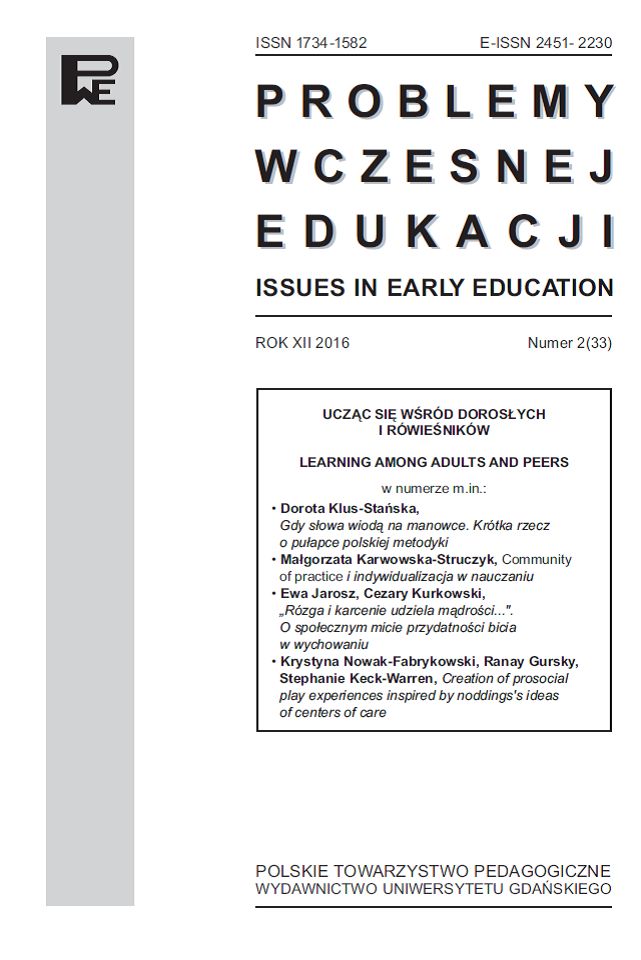Emergent literacy, visual literacy i czytanie dialogowe. Potencjał edukacyjny i emancypacyjny książki obrazkowej w środowisku rodzinnym i przedszkolnym
Słowa kluczowe:
książka obrazkowa, wczesna alfabetyzacja, alfabetyzacja wizualna, czytanie dialogoweAbstrakt
The article concerns contemporary perspectives on early education, early, emergent and visual literacy, and concepts of the development of cognitive, linguistic, and socio-emotional competencies by using picturebooks in the dialogic reading method. Picturebooks for small children, especially earlyconcept picturebooks, which present nouns, verbs, or adjectives and are aesthetically designed, have a great potential, and are important for the gaining of cognitive, emotional, and visual codes and ideas by the child, especially when they are introduced by an adult (parent at home or teacher in a preschool institution) through an active, dialogic manner of reading. Dialogic reading is shown and described by G.J. Whitehurst and other researchers as an interactive and stimulating method of cognitive and socio-emotional development, which enhances the children’s speaking and reading competencies independently of their class, race, or gender – which is of emancipatory significance. The main aim of the text is to turn the reader’s attention to the significance of interactive reading of precisely selected, high-quality picturebooks by parents and early education teachers in the context of children’s development.
Downloads
Bibliografia
Arizpe E., Colomer T., Martínez-Roldán C. (2014), Visual journeys through wordless narratives: An international inquiry with immigrant children and ‘The Arrival’. London, Bloomsbury Academic.
Bland J. (2013), Children’s literature and learner empowerment: children and teenagers in English language education. London, Bloomsbury Academic.
Brannon D., Dauksas L. (2014), The Effectiveness of Dialogic Reading in Increasing English Language Learning Preschool Children’s Expressive Language. „International Research in Early Childhood Education”, 1(5).
Brzezińska A. (red.) (1987), Czytanie i pisanie. Nowy język dziecka. Warszawa, WSiP.
Dylak S. (2012), Alfabetyzacja wizualna jako kompetencja współczesnego człowieka. W: S. Dylak, M. Skrzydlewski (red.) Media. Edukacja. Kultura. W stronę edukacji medialnej. Poznań – Rzeszów, Polskie Towarzystwo Technologii i Mediów Edukacyjnych.
Evans J. (1998), What’s in the picture? Responding to Illustrations in Picture Books. London Paul Chapman Publishing.
Huebner, C.E., Payne, K. (2010), Home support for emergent literacy: Follow-up of a communitybased implementation of dialogic reading. „Journal Of Applied Developmental Psychology”, 31(3).
Kiefer B.Z. (1995), The Potential of Picturebooks. From Visual Literacy ro Aesthetics Understanding. Columbia, Pearson.
Klus-Stańska D., Nowicka M. (2005), Sensy i bezsensy edukacji wczesnoszkolnej. Warszawa, WSiP.
Kress G., van Leeuwen T. (1996), Reading Images: The Grammar of Visual Design. London, Routledge.
Kummerling-Meibauer B. (red.) (2011), Emergent Literacy. Children’s books from 0 to 3. Amsterdam/Philadelphia, John Benjamins Publishing Company.
B. Kummerling-Maibauer, Meibauer J. (2011), Early-concept books. Acquiring nominal and verbal concepts. W: B. Kummerling-Meibauer (red.) Emergent Literacy. Children’s books from 0 to 3. Amsterdam/Philadelphia, John Benjamins Publishing Company.
Mourao, S.J. (2012), English picturebook illustrations and language development in early years education. Ph.D. thesis, Portugal, University of Aveiro.
Słońska I. (1959), Dzieci i książki. Warszawa, Państwowe Zakłady Wydawnictw Szkolnych.
Słońska I. (1977), Psychologiczne problemy ilustracji dla dzieci. Warszawa, PWN.
Szuman S. (1951), Ilustracja w książkach dla dzieci i młodzieży. Kraków, Wiedza Zawód Kultura Tadeusz Zapiór.
Whitehurst, G.J., Arnold, D.S., Epstein, J.N., Angell, A.L., Smith, M., Fischel, J.E. (1994), A picture book reading intervention in day care and home for children from low-income families. „Developmental Psychology”, 30(5).
Whitehurst G.J., Lonigan Ch. J. (1998), Child Development and Emergent Literacy. „Child Development”, 69(3).
Whitehurst, G.J. (2000), Early Intervention To Promote Preschoolers’ Language Skills: Dialogic Reading. “Focal Point. A National Bulletin on Family Support and Children’s Mental Health”, 14(1).
Zygouris-Coe V. (2001), Emergent Literacy. Florida Literacy and Reading Excellence (FlaRE) Center, University of Central Florida. https://education.ucf.edu/mirc/Research/Emergent%20 Literacy.pdf, 10.02.2016.

 Uniwersyteckie Czasopisma Naukowe
Uniwersyteckie Czasopisma Naukowe





